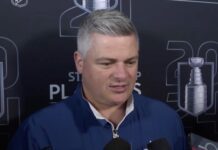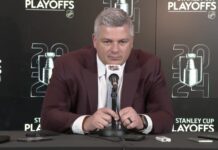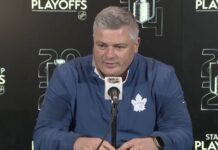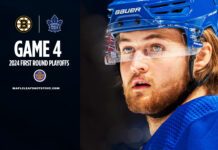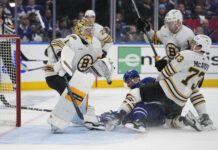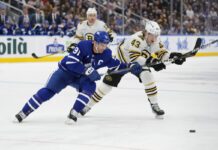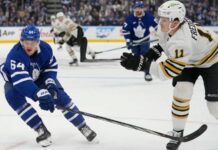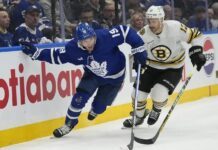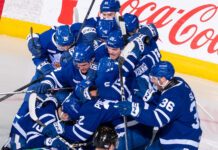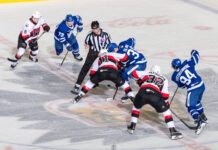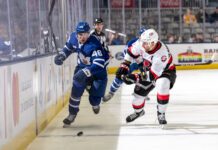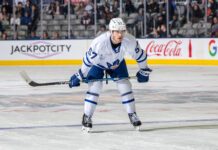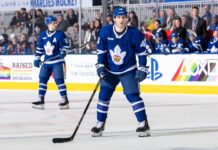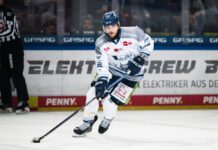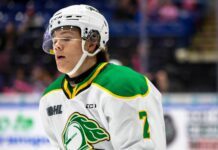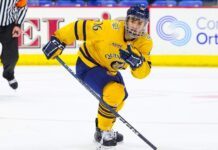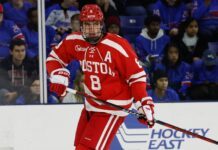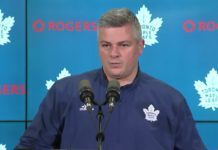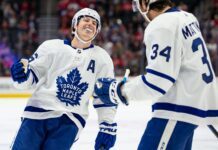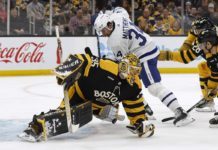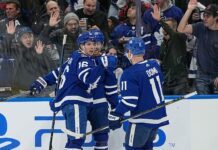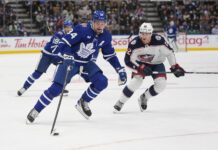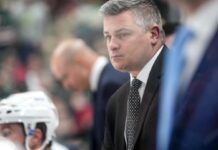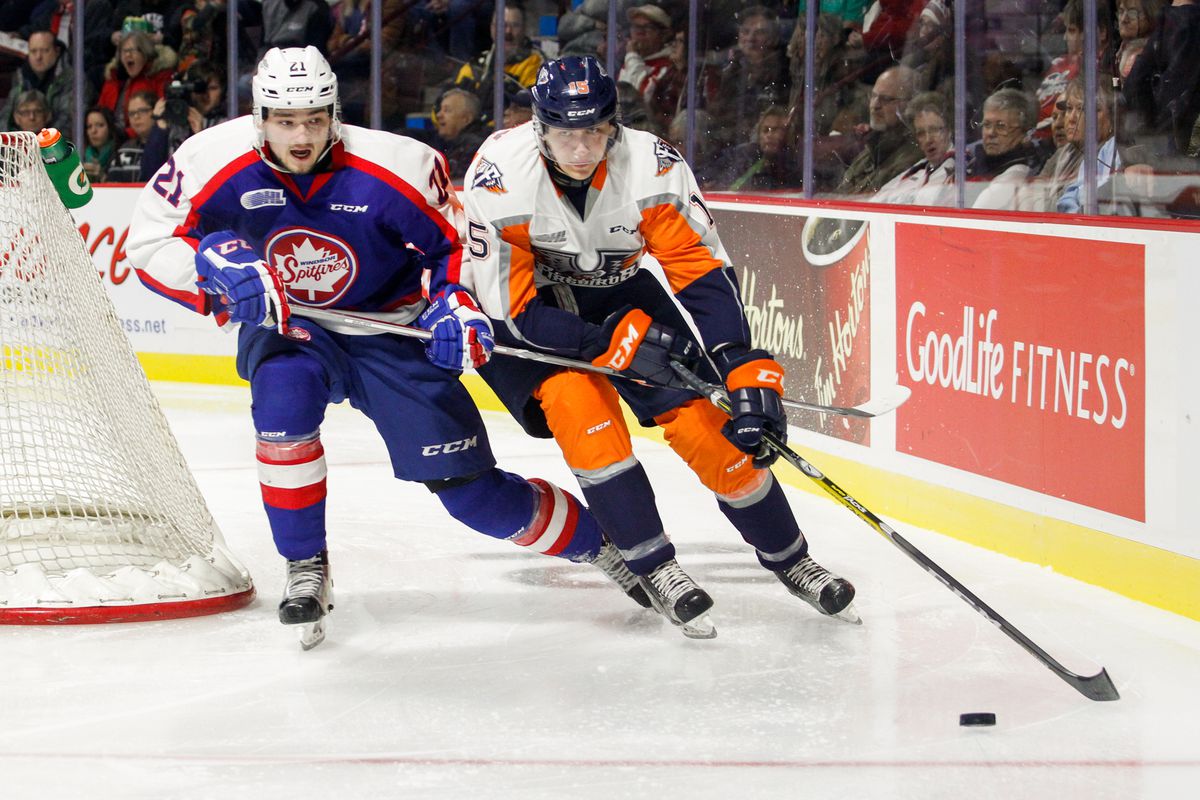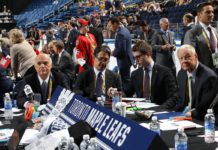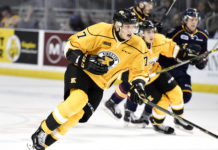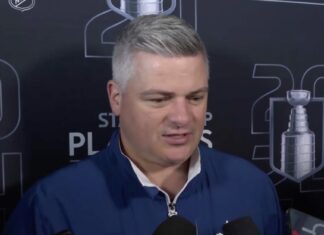In the fifth round of the 2017 draft, the Toronto Maple Leafs selected their second manatee-sized defenceman of the day in the six-foot-six Fedor Gordeev of the Flint Firebirds.
For more on Gordeev’s background and scouting profile, check out our post from earlier today. To get a better feel for Fedor’s game, I chatted with Flint Firebirds head coach Ryan Oulahen earlier this evening. Oulahen brings the added perspective of having attended training and development camps under Maple Leafs head coach Mike Babcock during his playing career as a former fifth-round pick of the Detroit Red Wings in 2003.
The condensed version of our conversation is below.
Fedor’s a Toronto kid and mentioned he shed some tears when he heard the Leafs drafted him, which certainly warmed some hearts in Leafs Nation. Is he the type of kid who wears his heart on his sleeve?
Oulahen: Absolutely. He came over when he was young. He grew up in Toronto in a very hard working family that’s had to earn it in the Toronto area. When we saw he got picked by Toronto, we knew that things happen for a reason and he would be quite happy and emotional about it. That doesn’t surprise me that was his reaction.
What did you guys know and like about him that motivated you to include him in the trade that sent Will Bitten to Hamilton early in the year?
Oulahen: I actually got a chance to coach Fedor at the Hockey Canada Under-17 program and I had him for two weeks on my team out in Calgary the year previous. I got to know him. When you’re with the kids for two weeks out there, you’re really learning about character and behaviour. All of that was what really drew us to him. And, of course, his physical attributes of being 6’6 and the way he can skate. It was all of those things, along with us building a culture here in Flint. Taking over a program and really starting to build the culture, we wanted high character and high-quality kids. That all matched up. That was a no-brainer for us. You always see, when a team makes a trade, a little bit of a connection somewhere. That was the one for me for sure. I knew Fedor previously and it was a no-brainer that he was the guy we wanted.
Can you give me a sense of the role he played for you guys after the trade and how it transformed throughout the season?
Oulahen: He was fighting between forward and defence and where was he going to play. We traded for him, and I said to him straight up, “We traded for you to be a defenceman, so you’re going to be a defenceman. You’re going to have to be patient and grow and develop into that position.” He came along quite fast and played a pretty significant role for us with top-four minutes. He got some power play time and a little bit of penalty kill time while developing his all-around game. That was his role last year.
We had a veteran defence as well. We had two overagers and a 19-year-old who signed with Arizona. Fedor was the fourth guy in our mix. Those older players have now left and he’s going to have tons more responsibility this year. The sky’s the limit for him.
Do you think he’s done growing?
Oulahen: I just saw him today and he looks even bigger. During the season, he grew an inch and a half. He was 6’4 and a half when we traded for him and he left at 6’6.
This season was his first full year in the OHL and he put up just the 13 points. He’s someone who has shown some real flashes of offensive upside at lower levels. How much room do you think he has to grow offensively with an OHL season under his belt now?
Oulahen: I think it’s going to be incredible. I really do. It’s not an easy position to play as a rookie and it was his first year in the league. We knew of him the year previous when he played Junior B in Ancaster. He put up real good numbers offensively as a guy who ran the power play there. It’s a different level, but we know it’s in him. This year, it is going to be nothing but more confidence for him. I think you’re going to see a guy that now breaks through offensively and can consistently contribute on the power play and at five on five. With his body and being so big, I wouldn’t say he’s as strong as he needs to be right now because he grew so fast. Once he fills that out and gets his strength, his shot is going to be better. His natural instincts will allow him to put up some numbers.
I was talking to someone who scouted him back in the GTHL, and he was saying he was a kid who was obviously super talented, and good for a jaw-dropping rush a game, but also a couple of frustrating turnovers per night. He mentioned all of the physical tools are there but the decision-making can let him down. Is that still a fair description?
Oulahen: I think we’ve gotten away from that with him. He actually got to the point where he’s pretty safe with the puck. Again, it was his first year in the OHL, so those guys would see him in a different element. In his first year, we were trying to push him to try things a little bit more, and try to be a little bit more offensive and jump up into the rush. Sometimes he perhaps reverted to not wanting to make a mistake.
I wouldn’t say that was the case. As we go forward here, he is a guy that we’re going to allow to jump up. He’s got unbelievable skating ability and we’re going to allow him to go. When he’s got the puck and he’s trying to jump and trying to make things happen, we’re going to have to live with some mistakes, for sure.
When he gets a head of steam with the puck he’s a pretty hard guy to take it off of, and he also has the ability to beat guys one on one. Is that partially the product of having some experience and history at the forward position?
Oulahen: That’s exactly what I was going to say. I think that’s why he can do that. Nowadays, when a lot of teams play the four-man attack, the guy carrying the puck wide a lot of times, if you’re activating your defence, is the defenceman. When he gets that opportunity, because he has that forward instinct, he can do that. He has a patented move: He can drive wide on guys, pull it, and protect it right across the net.
Didn’t he score an OHL Goal of the Week candidate doing that?
Oulahen: Yeah, when he was in Hamilton still. He did that a few times here and didn’t score, but he created. That’s what he can do.
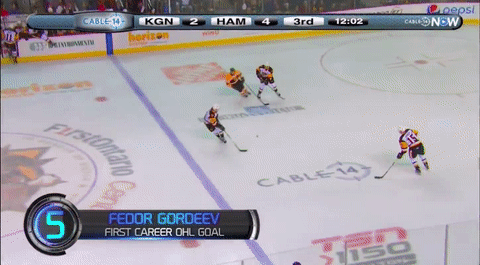
Defensively, he has some God-given tools going for him with his reach and size. He seems to be quite good at defending in controlled situations in the corners, along the boards and in front of the net — good at winning his battles by leaning on guys and leveraging his size and stick – but not as good in open ice defending one-on-one.
Oulahen: There is no question that is the area for improvement. It’s a case of learning the position. We have patience with him. Where he came from – from the start of the year to the end of the year – is remarkable. He hasn’t been playing defence for a long time. Your head coach would tell you it’s the hardest position to learn.
For me personally, I’m pretty excited he got to go to Toronto because I know how they play and I know the focus. I know the fundamentals that Mike Babcock preaches having played in Grand Rapids and grown up under Babcock going to the training camps. I know exactly what Fedor is in for here and I’m super excited that he’s going to get a taste of that. It’s going to help our guys in our club, too.
What do you think makes Babcock’s school of defence a good fit for Fedor in terms of the Babcock system?
Oulahen: It’s a good fit because stick on puck is crucial. There is nothing better than a guy who is 6’6 with a huge stick. That is a huge advantage over a guy who is 6’0. Just your stick alone, if you compare the sticks, means one is six inches longer than the other. It takes away time and space. That’s a characteristic that the Leafs probably saw in Fedor. Once he is taught more and learns that craft even better, he’s going to fit their system perfectly.
There is also the skating ability, being able to get out of trouble and jump up in the rush. When you combine those two things, you can see why it would be a fit in Toronto.
On the note of Babcock, Detroit and Grand Rapids, you would’ve played alongside some bigger defencemen like Jonathan Ericsson and Jakub Kindl. They’re not quite as big as Fedor nor do they play the same, but they’re certainly big-bodied d-men. Are there any similarities there at all? They’re more ‘stay-at-home,’ but both are big guys with big sticks that played for Babcock.
Oulahen: I kind of do see the similarities to maybe a Jonathan Ericsson – not in the way they play, but their career path. Jonathan Ericsson might have been the last pick of the draft that I was in. He wasn’t anything special. You could see he was a big guy. You could see he could skate. But he didn’t really wow you. And then all of a sudden, two years later, we came in at the same year after signing and this guy was unbelievable. That’s what I could see with Fedor. It’s exciting what he is already, but I know the potential when you can move like he can move. He’s in a state where he’s finishing growing and getting stronger and is getting more comfortable controlling that big frame. He’s going to turn into a promising young guy. You talk about the potential to play in the NHL – a 6’6 kid that can skate and move the way he does? The potential is there.
Interviews on Eemeli Rasanen and Ian Scott to follow later this week


